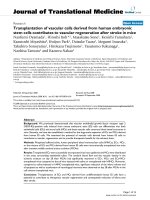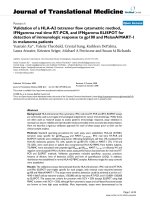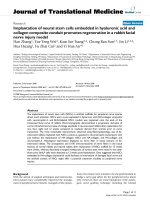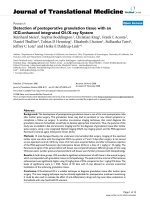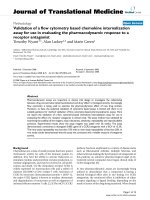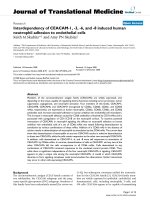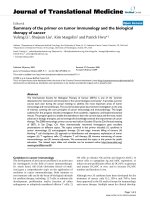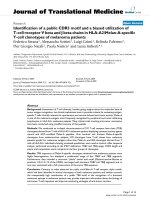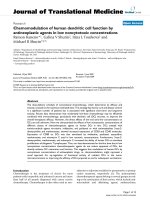Báo cáo hóa học: " Prevention of upper limb symptoms and signs of nerve afflictions in computer operators: The effect of intervention by stretching" potx
Bạn đang xem bản rút gọn của tài liệu. Xem và tải ngay bản đầy đủ của tài liệu tại đây (431.52 KB, 13 trang )
BioMed Central
Page 1 of 13
(page number not for citation purposes)
Journal of Occupational Medicine
and Toxicology
Open Access
Research
Prevention of upper limb symptoms and signs of nerve afflictions in
computer operators: The effect of intervention by stretching
Jorgen R Jepsen*
†
and Gert Thomsen
†
Address: Department of Occupational Medicine, Sydvestjysk Sygehus, Østergade 81-83, DK-6700 Esbjerg, Denmark
Email: Jorgen R Jepsen* - ; Gert Thomsen -
* Corresponding author †Equal contributors
Abstract
Background: In a previous study of computer operators we have demonstrated the relation of
upper limb pain to individual and patterns of neurological findings (reduced function of muscles,
sensory deviations from normal and mechanical allodynia of nerve trunks). The identified patterns
were in accordance with neural afflictions at three specific locations (brachial plexus at chord level,
posterior interosseous and median nerve on elbow level). We have introduced an intervention
program aiming to mobilize nerves at these locations and tested its efficacy.
Methods: 125 and 59, respectively, computer operators in two divisions of an engineering
consultancy company were invited to answer a questionnaire on upper limb symptoms and to
undergo a blinded neurological examination. Participants in one division were subsequently
instructed to participate in an upper limb stretching course at least three times during workdays in
a six month period. Subjects from the other division served as controls. At the end of the
intervention both groups were invited to a second identical evaluation by questionnaire and
physical examination. Symptoms and findings were studied in the right upper limb. Perceived
changes of pain were recorded and individual and patterns of physical findings assessed for both
groups at baseline and at follow-up. In subjects with no or minimal preceding pain we additionally
studied the relation of incident pain to the summarized findings for parameters contained in the
definition of nerve affliction at the three locations.
Results: Summarized pain was significantly reduced in the intervention group but unchanged in
controls. After the intervention, fewer neurological abnormalities in accordance with nerve
affliction were recorded for the whole material but no conclusion could be drawn regarding the
relation to the intervention of this reduction. Incident pain correlated to findings in accordance
with the three locations of nerve affliction.
Conclusion: A six month course of stretching seems to reduce upper limb symptoms in computer
operators but we could not demonstrate an influence on neurological physical findings in this
sample. The relation of incident symptoms to identified neurological patterns provides additional
support to the construct validity of the employed neurological examination.
Published: 7 January 2008
Journal of Occupational Medicine and Toxicology 2008, 3:1 doi:10.1186/1745-6673-3-1
Received: 3 August 2007
Accepted: 7 January 2008
This article is available from: />© 2008 Jepsen and Thomsen; licensee BioMed Central Ltd.
This is an Open Access article distributed under the terms of the Creative Commons Attribution License ( />),
which permits unrestricted use, distribution, and reproduction in any medium, provided the original work is properly cited.
Journal of Occupational Medicine and Toxicology 2008, 3:1 />Page 2 of 13
(page number not for citation purposes)
Background
Neck-shoulder-arm pain is frequent among computer
workers but there is a controversy with regard to the char-
acter of disorders responsible for these symptoms and
their prevention remains a challenge. However, in heavily
exposed symptomatic computer operators it is possible to
identify neurological abnormalities including selective
muscle weakness, deviation from normal of sensibility,
and mechanical allodynia of nerve trunks. The occurrence
of physical findings in distinct neurological patterns sug-
gests the involvement of the brachial plexus at chord level
(located infraclavicularly behind the pectoralis minor
muscle), and of the posterior interosseous and median
nerves at elbow level [1]. These patterns were identified by
a neurological examination which has been previously
shown to be reproducible and reflecting symptoms [2-4].
Applied to a sample of computer operators with few and
minor symptoms, a similar neurological examination has
demonstrated the presence and relation to symptoms of
specific patterns of abnormalities [5]. While this study did
not intend to determine the relation of upper limb symp-
toms to computer work, the findings are concurrent with
hypotheses of external causation of work-related upper
limb nerve-afflictions [6,7] including the relation to office
work [8].
Researchers seem to share the view that computer use
(hours per day or week) is related to upper limb morbidity
[9]. However, those involved in computer intensive work,
e.g. computer aided design, are reluctant to accept half-
time jobs and other preventive options likewise appear
insufficient. A recent Cochrane review has concluded that
there is limited evidence for the efficacy of exercises and
breaks and that the benefit of ergonomic interventions
has not been clearly demonstrated [10]. While education
in office ergonomics has resulted in less pain and discom-
fort in some studies [11-13] others have failed to demon-
strate this effect [14]. The effect of work environment
improvements seems to be superior when combined with
changes in work techniques [15]. One study has suggested
the preventive role of forearm support [16] while others
found no effect of postural interventions [17].
The failure of ergonomically designed workstations to sat-
isfactorily prevent adverse musculoskeletal health effects
has been attributed to their inability to correct for a major
contribution of constrained posture. To address this factor
computer operators have been recommended physical
exercises many of which, however, have been regarded as
conspicuous and potentially embarrassing to perform, as
disruptive of work routines, as posing health hazards by
exacerbating the biomechanical stress in computer work,
or as contraindicated in subjects with certain health prob-
lems [18]. The limited evidence for the effectiveness of
exercises may be due to their content which constituted
strengthening and endurance rather than stretching [10].
One study has shown that frequent short breaks from
computer work improve productivity and well-being
when the breaks integrate with task demands – especially
when combined with stretching exercises [19]. In another
study recovery from upper limb and neck complaints was
promoted by regular breaks but there was no additional
effects of physical exercises [20]. In a review of the efficacy
of stretching for prevention of injury related to exercise
(sports) no conclusions could be drawn due to the pau-
city, heterogeneity and poor quality of studies [21]. Iso-
lated stretching exercises have not been studied in
computer operators but were rated as beneficial by ultra-
sonography staff with musculoskeletal complaints [22].
The static components in ultrasound examinations may
be comparable to that of computer work but the forces
involved are higher and the variability of upper limb pos-
ture probably greater.
A recent systematic review of the effect of interventions
among computer users found that our ability to draw con-
clusions about ergonomic interventions including the
effect of rest brakes and exercises was limited by the small
number of good quality studies [23].
Our clinical observations have indicated that upper limb
symptoms and physical findings may still develop in com-
puter workers in spite of attempts to optimize ergonomics
and work organization, e.g. by reducing computer work-
load through addressing deadlines and overtime. The cur-
rent insufficiency of effective preventive measures suggests
the need for a broader scope.
Physical findings in computer operators [5] suggest that at
specific anatomic locations with narrow passages nerve
trunks may be compressed, tethered or fixed by surround-
ing structures. Accordingly, a rational preventive approach
would aim to maintain nerve-mobility at these locations.
This may be accomplished by influencing gradients of tis-
sue pressure in order to improve capillary blood flow and
venous return in nerves [24,25] and by re-establishing
muscle balance (e.g., through strengthening of specific
muscles and stretching of their antagonists) [7].
These considerations and prior encouraging experiences
[19,22] influenced our decision to study if stretching exer-
cises aiming to mobilize the nerves at specific locations
can reduce upper limb symptoms in computer operators.
The demonstration of a beneficial effect of such targeted
stretching would contribute to the prevention of upper
limb pain in computer operators and also provide a fur-
ther validation of the previously presented diagnostic
approach [2-4].
Journal of Occupational Medicine and Toxicology 2008, 3:1 />Page 3 of 13
(page number not for citation purposes)
We have aimed to test the value of such an intervention.
Methods
Design
The study was a controlled interventional trial and
involved one company with divisions in several cities
countrywide. The work tasks in each division were compa-
rable. Allocation to the intervention group or control
group was based on geography with the intervention
department located in the city of Esbjerg and the control
department geographically separated in Aarhus.
Before and after the intervention, data were collected by
questionnaires and physical examinations.
Material
The study base consisted of 125 and 59 computer opera-
tors, respectively, in two divisions of a Danish engineering
company Rambøll A/S situated in Esbjerg and Aarhus,
respectively (Figures 1, 2). All participants were employed
as engineers or technical assistants. They were selected for
being exposed to graphical computer work for more than
20% of their total working time or having experienced
upper limb symptoms within the last 12 months.
The study complied with the Helsinki declaration. It was
approved by the local Ethics Committee (2487A-03) and
signed informed consent was obtained from all partici-
pants.
Questionnaire
The questionnaires were based on the Nordic Question-
naire [26] and designed for electronic completion and
submission. The posed questions included perceived pain
during the last three months. Answers were scored on a
VAS-scale 0 ("no pain") – 9 ("intolerable pain") for each
of three regions (shoulder, elbow, and hand/wrist) on
both sides. The questionnaires employed at baseline and
at follow-up were identical except for additional ques-
tions in the latter on the extent to which the respondent
had participated in the intervention and whether the
symptoms in each region had changed. The latter was
reported on a 5 point scale from "much worse" to "much
better".
Physical examination
Selected neurological parameters which were included in
a formerly presented detailed examination protocol [2,3]
were semi-quantifiable assessed (Table 1). The following
parameters were examined bilaterally:
Wenn diagram illustrating the studied samples of intervention subjectsFigure 1
Wenn diagram illustrating the studied samples of intervention subjects.
Journal of Occupational Medicine and Toxicology 2008, 3:1 />Page 4 of 13
(page number not for citation purposes)
• 11 individual muscles (Table 2) were manually tested
simultaneously on the two sides in order to reveal any dis-
crepancy in between the right and left side. Aiming to sta-
bilize the limb, minimize discomfort and ensure a
biomechanical optimal positioning during testing of a
specific muscle while disfavouring the influence of others,
specific postures have been carefully defined for each
muscle. Up to three reiterations of each test were per-
formed in order to identify abnormal fatigue. The intent
was to assess the peak function as well as the ability of the
individual to hold the force at a constant level during test-
ing thus containing a component of endurance. The level
of function of each muscle was graded between 0 and 5
with subdivision of grade 4 into 4-, 4, and 4+ [2,27]
(Table 1).
• Algesia (needle prick) was assessed in five and the
threshold to perception of vibration by use of a tuning
Wenn diagram illustrating the studied samples of control subjectsFigure 2
Wenn diagram illustrating the studied samples of control subjects.
Table 1: Quantification of the neurological qualities examined
Examined quality Interpretation
Manual isometric muscle testing in individual muscles [2] 5 Contraction against powerful resistance/normal power = 0
4+ Contraction against gravity and strong resistance = 1
4 Contraction against gravity and moderate resistance = 2
4- Contraction against gravity and slight resistance = 3
Mechanosensitivity with slight pressure along nerve trunks [3] No soreness = 0
Mild mechanical allodynia = 1
Moderate mechanical allodynia = 2
Severe mechanical allodynia = 3
Sensibility examined by needle prick (algesia) and tuning fork 256 Hz
(vibratory threshold [3])
Normal sensibility = 0
Reduced/changed sensibility = 1
Severely reduced/changed sensibility = 2
Journal of Occupational Medicine and Toxicology 2008, 3:1 />Page 5 of 13
(page number not for citation purposes)
fork 256 Hz in three innervation territories (Table 3) as
formerly described [3]. Deviation of sensibility was classi-
fied as "severely reduced/changed" when an allodynic
reaction was recorded, or when pain or vibration could
either not be perceived at all or was altered sufficiently to
be clearly apparent to the examiner from the patient's
reaction. Deviation of sensibility was classified as
"reduced/changed" with any other divergence from nor-
mal (dys-, hypo-, or hypersensibility). For the latter assess-
ment, sensation was compared with sensibility in other
territories assessed as normal (Table 1).
• The mechanosensitivity (soreness) of nerve trunks was
examined at seven locations by palpating with a moderate
manual pressure (3 kp) from proximal to distal (Table 4).
Mechanical allodynia was quantified according to Table 1.
"Severe" mechanical allodynia was registered with avoid-
ance reaction/jump sign, "moderate" allodynia when the
patient expressed the pressure as seriously uncomfortable
and "mild" allodynia with the presence of any other sore-
ness exceeding normal. For the latter assessment, the level
of soreness was compared to reactions regarded as normal
to pressure elsewhere along nerves (Table 1).
The examiner was aware of the affiliation of each exam-
ined subject to one or the other division of the company
but was otherwise blinded to any information relating to
the study subjects including their answers to the question-
naire. No communication occurred during the physical
examination except for instructions from the examiner
and reactions from the subjects to the applied tests.
Intervention
A physiotherapist from the occupational health service
instructed subjects in the intervention group in stretching
exercises based on neurodynamic principles [24,25].
Groups of 10–12 employees were instructed in sessions of
20 minutes during which the exercises were demonstrated
twice. A pamphlet with text and illustrations of the
stretching exercises were handed out to the participants
who were encouraged by the therapist to complete the
program at least three times daily during work hours and
additionally after hours over a 6-months period. During
the intervention the therapist was available at the worksite
once a month for employees who wanted ergonomic con-
sultations. The intervention was based on the "intention
to treat" concept and no further encouragement to con-
tinue stretching was provided.
The first (Stretching 1) and second (Stretching 2) exercise
aimed to stretch the volar forearm flexors and the second
additionally to stretch the pronator muscle. The third
(Stretching 3) and the fourth (Stretching 4) exercises,
respectively, aimed to mobilize the median and radial
nerve, respectively. The following instructions for stretch-
ing were given:
• Stretching 1: "Keep your arms along the front of the
body with extended elbows. Fold your hands and rotate
forearms to point the dorsum of the hands backwards.
Raise your completely extended arms overhead and max-
imally backwards. Flex one elbow behind your neck while
gripping the elbow with your opposite hand pulling it
towards the middle. Keep this position for a few seconds.
Repeat on the other side. Stretch arms and move them in
the lateral direction and back to the start position. Repeat
one time. Duration approximately 30 seconds".
• Stretching 2: "Place yourself standing at the side of your
desk with extended elbows, outward-rotated forearms and
fingers pointing backwards toward your body, palms flat
on the desk and wrists extended maximally backwards.
Repeat one time. Duration approximately 20 seconds".
• Stretching 3: "Place your hand flat on a wall with fingers
pointing backwards, elbow stretched, and shoulder low-
ered (kept down by the other hand) and if possible flex
your head away from the arm. Duration approximately 20
seconds. Repeat on the other side" (Figure 3).
• Stretching 4: "Place your thumb in the palm and grip
around your thumb with maximal forearm inward-rota-
tion. Grip hand/fingers with the opposite hand and flex
the inward-rotated wrist. Lower the shoulders. Extend
Table 2: Reported change in symptoms at follow-up for responders to the second questionnaire analyzed by Wilcoxon rank-sum
(Mann-Whitney) test
Intervention subjects. N = 66 Control subjects. N = 30
Region Worse or
much worse
Unchanged Better or
much better
Worse or
much worse
Unchanged Better or
much better
P
Shoulder 3 47 16 1 27 2 0.04
Elbow 2 54 10 2 27 1 0.06
Wrist/hand 6 46 14 3 26 1 0.09
Aggregated 8 35 23 5 21 4 0.02
Journal of Occupational Medicine and Toxicology 2008, 3:1 />Page 6 of 13
(page number not for citation purposes)
Table 3: Outcome of individual muscle testing at baseline and at follow-up. Analysis by Wilcoxon signed-rank test of the relation between findings at the two occasions
(for subjects examined twice)
Intervention subjects. N = 69 Control subjects. N = 28
Muscle Number with weakness at baseline Number with weakness at follow-up P Number with weakness at baseline Number with weakness at follow-up P
Grade 4+ Grade 4 or less Grade 4+ Grade 4 or less Grade 4+ Grade 4 or less Grade 4+ Grade 4 or less
Pectoral 0 0 0 0 - 0 0 0 0 -
Deltoid 9 3 9 0 0.23 8 1 1 0 0.005
Latissimus 30100.1550100.10
Infraspinatus 6 0 3 0 0.18 2 0 1 0 0.32
Biceps 7 2 8 0 0.32 7 1 2 0 0.03
Triceps 24120 00.2012111 00.37
Radial flexor of wrist 12 1 11 0 0.58 7 1 7 0 0.71
Short radial extensor of wrist 10 2 9 0 0.15 8 0 6 0 0.53
Ulnar extensor of wrist 18 1 11 0 0.08 7 0 10 0 0.37
Short abductor of thumb 18 1 12 0 < 0.05 7 1 8 0 0.94
Abductor of small finger 5 0 3 0 0.32 0 0 0 0 -
Journal of Occupational Medicine and Toxicology 2008, 3:1 />Page 7 of 13
(page number not for citation purposes)
Table 4: Sensory findings at homonymously innervated territories at baseline and at follow-up. Analysis by Wilcoxon signed-rank test of the relation between sensibility
(algesia and vibratory threshold) at the two occasions (for subjects examined twice)
Intervention subjects. N = 69 Control subjects. N = 28
Innervation
territory
Number of abnormalities at baseline Number of abnormalities at follow-up P Number of abnormalities at baseline Number of abnormalities at follow-up P
Slight Severe Slight Severe Slight Severe Slight Severe
Algesia Axillary 19 0 18 1 0.97 5 0 7 0 0.53
Musculocutaneous 15 1 13 1 0.65 5 0 6 0 0.30
Median 13 0 13 0 1.00 2 0 4 0 0.41
Radial 13 0 8 0 0.17 5 0 4 0 0.71
Ulnar 1 0 1 0 1.00 1 0 0 0 0.32
Vibration Median 42 1 30 1 0.30 11 0 11 0 0.10
Radial 46 0 27 0 0.005 20 0 10 0 0.17
Ulnar 16 0 7 0 0.07 12 0 9 0 1.00
Journal of Occupational Medicine and Toxicology 2008, 3:1 />Page 8 of 13
(page number not for citation purposes)
neck backwards away from arm. Duration approximately
20 seconds. Repeat on the other side" (Figure 4).
During the study period no other work organizational
interventions had occurred at any of the two sites. Besides
the physical examination the control group received nei-
ther any placebo intervention nor any other attention of
any kind.
Outcome data
The main outcomes were changes with regard to symp-
toms and physical findings. We have looked at the follow-
ing data:
• Self-reported change of pain level. Calculations were
made for subjects who answered the follow-up question-
naire.
• Changes from baseline to follow-up among subjects in
the intervention group and among the controls
ؠ of self-reported pain. Calculations were made for sub-
jects who answered both questionnaires.
ؠ of neurological findings in isolation and of their occur-
rence in patterns in accordance with the presence of afflic-
tions of the brachial plexus, the posterior interosseous
nerve, and the median nerve at elbow level, respectively.
The definition of neurological patterns has been described
previously [5]. Calculations were made for subjects who
participated in both physical examinations.
• The development of pain in subjects with no pain or
with a minor pain score (less than 2) summarized for
three regions (hand, elbow, shoulder). Calculations were
made for subjects who answered both questionnaires and
participated in the first physical examination.
Statistics
Paired samples were studied by a Wilcoxon signed rank-
sum test and non-paired samples of the same parameters
by a two-sample Wilcoxon rank-sum (Mann-Whitney)
test.
All calculations were made by the STATA statistical packet
ver. 8.2.
Results
All the presented results refer to the right upper limb.
Stretching 4 addressing the structures surrounding the radial nerve (right side)Figure 4
Stretching 4 addressing the structures surrounding the radial
nerve (right side).
Stretching 3 addressing the structures surrounding the median nerve (right side)Figure 3
Stretching 3 addressing the structures surrounding the
median nerve (right side).
Journal of Occupational Medicine and Toxicology 2008, 3:1 />Page 9 of 13
(page number not for citation purposes)
Compared to the intervention subjects the controls were
slightly older (mean age 37 and 41, respectively) and the
proportion of women higher (66% and 33%, respec-
tively). The intervention subjects and the controls were
comparable with regard to mean body mass index (25 and
24, respectively).
Compliance with the recommended intervention was
generally good. Among the 66 subjects in the intervention
group who answered the second questionnaire 60
affirmed that they had regularly completed the stretching
exercises at the recommended rate and 53 that they
included all exercises. Two subjects out of the 30 controls
performed some sort of stretching (which would most
likely differ from the recommended exercises). The con-
tent of the work, work hours and ergonomic features of
work sites were unchanged and comparable in the two
groups during the course of the intervention.
At baseline/follow-up 120/66 computer operators in the
division in Esbjerg and 44/30 in Aarhus, respectively,
answered questionnaires about upper limb symptoms
and 80/70 computer operators in Esbjerg and 37/28 in
Aarhus, respectively, were subjected to physical examina-
tions by the same examiner (JRJ) (Figures 1, 2).
Symptoms
The baseline pain level was identical in the intervention
group and the control group. In the mouse-operating
limb pain was experienced by 67 subjects with summa-
rized pain being mostly slight (median score = 2, range 0
– 16) on a VAS scale 0 – 29. Contralateral pain was present
in 24 subjects and of lower intensity (median score = 0,
range 0 – 14). The summarized score exceeded 4 in 33 and
13 limbs, respectively, on the two sides [5].
On follow up after six months the application of the Wil-
coxon signed-rank test showed a significantly reduced
pain level among the 64 subjects in the intervention group
who answered both questionnaires (z = -3.368, p =
0.0008). No statistical change could be demonstrated for
the 18 controls (z = -1.590, p = 0.12) (Figures 1, 2 and 5).
Application of a two-sample Wilcoxon rank-sum test
(Mann-Whitney) was unable to demonstrate a significant
difference between the intervention group and the control
group (z = – 0.745, p = 0.46).
However, following the intervention, 23 out of 66 sub-
jects in the intervention group who answered the second
questionnaire reported improvement and 8 reported
more pain than before. In the control group the perceived
changes in pain in each direction were almost equal as 4
out of 30 subjects reporting fewer symptoms while 5
reported increased pain (Figures 1, 2).
A significant improvement was noted for the shoulder per
se (p = 0.04) but no significant change was reached for the
elbow and wrist/hand. Aggregation of data on symptoms
in the three regions resulted in an overall significant
improvement during the intervention (p = 0.02) (Table
2).
Findings
Individual findings
The changes relating to each physical parameter from
baseline to follow-up for the 69 subjects in the interven-
tion group and the 28 controls who were examined twice
is illustrated in Tables 3, 4, 5 (Figures 1, 2). A significant
improvement with regard to muscle function was reached
in the intervention group for the short abductor of the
thumb muscle and in the control group for the deltoid
and biceps muscles (Table 3). Algesia was not changed for
any innervation territory while the vibratory sense
improved significantly for the radial nerve in the interven-
tion group (Table 4). Mechanosensitivity was significantly
improved in the intervention group for the median nerve
(elbow) and the posterior interosseous nerve, and in the
control group for the infraclavicular portion of the bra-
chial plexus (Table 5).
Summarized individual findings
The summarized individual physical findings was reduced
in 35 and increased in 18 out of the 69 subjects in the
intervention group and in 13 and 10, respectively, of the
28 controls that were physically examined twice (Figures
1, 2). For the entire sample, the application of a Wilcoxon
signed-rank test demonstrated a significant reduction of
The summarized pain score in the intervention group (64 persons) and the control group (18 persons) before and after the interventionFigure 5
The summarized pain score in the intervention group (64
persons) and the control group (18 persons) before and after
the intervention.
Journal of Occupational Medicine and Toxicology 2008, 3:1 />Page 10 of 13
(page number not for citation purposes)
Table 5: Mechanosensitivity of nerve trunks at baseline and at follow-up. Analysis by Wilcoxon signed-rank test of the relation between mechanosensitivity
at the two occasions (for subjects examined twice)
Intervention subjects. N = 69 Control subjects. N = 28
Mechanosensitivity of nerve trunks Number with mechanical
allodynia at baseline
Number with mechanical
allodynia at follow-up
P Number with mechanical
allodynia at baseline
Number with mechanical
allodynia at follow-up
P
Mild Moderate to severe Mild Moderate to severe Mild Moderate to severe Mild Moderate to severe
Supraclavicular brachial plexus 3 0 0 0 0.08 2 0 0 0 0.16
Clavicular brachial plexus 3 1 3 0 0.41 3 0 2 0 0.65
Infraclavicular brachial plexus 14 6 14 0 0.05 8 5 4 0 0.004
Median nerve (elbow) 18 3 8 0 0.0003 8 5 6 0 0.002
Posterior interosseous nerve 26 4 13 0 0.0001 13 3 9 0 0.03
Ulnar nerve (sulcus) 0 0 0 0 - 1 0 0 0 0.32
Median nerve (carpal tunnel) 0 0 1 0 0.32 1 0 0 0 0.32
Journal of Occupational Medicine and Toxicology 2008, 3:1 />Page 11 of 13
(page number not for citation purposes)
physical findings at follow-up (p = 0.005). However, a
two-sample Wilcoxon rank-sum (Mann-Whitney) test
could not demonstrate any difference between the two
groups (p = 0.86) thus suggesting that physical findings
were unaffected by the intervention.
Patterns
According to the criteria for definition of the three pat-
terns of physical findings reflecting nerve-afflictions there
was a tendency towards fewer patterns in both groups, but
particularly in the intervention group in which 29 pat-
terns were identified at baseline and 7 at follow-up.
Among the controls the corresponding numbers were 18
and 9, respectively. This apparent difference was not sta-
tistically significant.
Incident symptoms and findings
For subjects scoring less than two on pain at the first meas-
urement (meaning minimal pain) we have analysed the
change at follow-up of summarized pain score of at least
one for 15, 12, and 14 limbs, respectively, with a pattern
in accordance with brachial plexopathy, posterior interos-
seous neuropathy, and median neuropathy at elbow level,
respectively. The slopes of the regression lines turned out
to be significantly positive for the patterns illustrating the
brachial plexus (p = 0.005) and the posterior interosseous
nerve (p = 0.02) and borderline significant for the pattern
reflecting the median nerve at elbow level (p = 0.052). In
spite of few numbers these findings suggest the relation of
incident symptoms to pathology at the three levels.
Discussion
Any preventive intervention should preferably be based
on an understanding of the phenomena underlying the
disorder or at least a theory founded on evidence with
regard to this issue. In the absence of such understanding,
any intervention may target irrelevant issues and would
most likely be ineffective. The intervention in this study
was based on indications from a former study of the rela-
tion of symptoms to upper limb nerve afflictions at three
locations (brachial plexus at chord level, posterior interos-
seous nerve and median nerve at elbow level) [5]. Accord-
ingly, a six month course of stretching was designed with
the aim to mobilize the nerve segments at these locations.
The ability of the intervention to reduce symptoms in the
studied sample of computer operators is encouraging. The
decrease after the intervention of physical findings in the
entire sample could not be related to the stretching exer-
cises, however. This is not necessarily contrary to the
favourable subjective improvement, but may be explained
by statistical weaknesses and other potential sources of
error.
First of all, the physical work environment of this small
sample of computer operators was already optimized
prior to the study. They also had fewer symptoms than
reported in other studies on upper limb complaints in
computer workers. These favourable circumstances in
terms of health would tend to make it more difficult to
demonstrate an effect of the intervention.
Secondly, 20 computer workers did not answer the ques-
tionnaire at start and 88 did not participate at the follow-
up (Figures 1, 2). For the physical examinations the corre-
sponding figures were 67 and 31 subjects, respectively. In
fact only 62 subjects in the intervention group and 16
controls participated in all parts of the study. This small
number especially of controls is a clear weakness, which
together with the high number of limbs without symp-
toms and findings reduces the statistical power of the
study.
The composition of the intervention group and the con-
trol group was comparable with respect to gender and age.
We did not analyse for prior disorders and psychosocial
factors but the two groups were of similar composition
with respect to age, sex, and educational and social back-
ground. We consider bias due to differences in exposure
or vulnerability in the two groups unlikely because of the
almost identical content and organization of work, work-
station ergonomics and psychosocial work environment.
We did not analyse for other covariates such as prior dis-
orders and psychosocial factors but the two groups were
comparable with respect to these factors.
Complete blinding of the physical examination could not
be achieved. This would demand randomization to the
intervention which, however, was deliberately offered to
staff in one division of an engineering company with con-
trols in a geographically separated division in order to
avoid mutual contacts between intervention and control
subjects and thus to prevent the controls to also engage in
the stretching exercises if the intervention subjects would
perceive them as beneficial. Apart from this, subjectivity
was reduced by performing all physical assessments
blinded to any other information about the studied com-
puter operators.
Findings were entered into patterns according to prede-
fined algorithms. Still, it cannot be excluded that one
finding, e.g. of weakness in a specific muscle, can bias
other findings such as sensory deviations because all phys-
ical examinations were made by the same examiner. The
execution of the examination may have changed slightly
from baseline to follow-up. However, the intra-examiner
reliability of the applied examination is likely to be good
because the inter-examiner reliability has previously been
found satisfactory [2,3]. It may also be argued that a ten-
Journal of Occupational Medicine and Toxicology 2008, 3:1 />Page 12 of 13
(page number not for citation purposes)
dency of the study subjects towards more familiarity with
the physical examination at the second examination
could result in muscle function for example improving
over time or nerve trunk soreness being perceived as less
uncomfortable than previously. These potential sources of
bias cannot be overcome.
A certain fluctuation of findings was noted in the inter-
vention group as well as among controls. However, per-
sistence for some time of physical neurological findings
which appear to be characteristic for peripheral nerve
afflictions would result in a reduced influence on physical
findings of the intervention. Our clinical experiences with
assumed neuropathic upper limb conditions suggest that
patients reporting fewer symptoms at control visits after
successful treatment may still present unchanged levels of
pareses and sensory dysfunction. It therefore seems possi-
ble that a significant reduction of physical findings would
require a follow-up of longer duration.
There is no indication that effective prevention can be
accomplished by the isolated use of stretching exercises.
However, as a supplement to ergonomic and organiza-
tional change stretching may well contribute to reduce the
burden of computer-related upper limb disorders.
The outcome of this intervention may serve to further
illustrate the character of computer-related upper limb
disorder by indicating the relation of incident symptoms
to neurological patterns suggesting nerve-afflictions with
specific locations. Consequently, it contributes to a fur-
ther validation of the employed physical examination [2-
4].
Conclusion
When performed three times a day stretching designed to
improve the available space and mobility of nerves at the
infraclavicular brachial plexus and the posterior interos-
seous and median nerves at elbow level can reduce com-
puter-related upper limb pain. However, no firm
conclusions can be drawn with regard to an influence on
physical findings except for the observation that incident
symptoms were related to findings suggesting pathology
at the three levels. The results of this study may contribute
to the prevention of computer-related upper limb disor-
ders and also provide support to hypotheses on the role of
peripheral nerve-afflictions in these conditions.
Competing interests
The author(s) declare that they have no competing inter-
ests.
Authors' contributions
G Thomsen and J R Jepsen have designed the study. J R
Jepsen collected the data relating to the physical examina-
tion. G Thomsen was responsible for the electronic ques-
tionnaire, data-management and the statistical
calculations. J R Jepsen prepared the manuscript which
has been approved by G Thomsen.
Acknowledgements
The management and staff of Rambøll A/S, Denmark are thanked for enthu-
siastic support to and participation in this project and for sharing the
expenses related to the execution.
References
1. Jepsen JR: Upper limb neuropathy in computer operators? A
clinical case study of 21 patients. BMC Musculoskeletal Disorders
2004, 5:26 [ />].
2. Jepsen J, Laursen L, Larsen A, Hagert CG: Manual strength testing
in 14 upper limb muscles. A study of the inter-rater reliabil-
ity. Acta Orthop Scand 2004, 75:442-448.
3. Jepsen JR, Laursen LH, Hagert CG, Kreiner S, Larsen AI: Diagnostic
accuracy of the neurological upper limb examination I. Inter-
rater reproducibility of findings and patterns. BMC Neurology
2006, 6:8.
4. Jepsen JR, Laursen LH, Hagert CG, Kreiner S, Larsen AI: Diagnostic
accuracy of the neurological upper limb examination II. The
relation to symptoms of patterns of findings. BMC Neurology
2006, 6:10.
5. Jepsen JR, Thomsen G: A cross-sectional study of the relation
between symptoms and physical findings in computer oper-
ators. BMC Neurology 2006, 6:40.
6. Armstrong TJ, Buckle P, Fine L, Hagberg M, Jonsson B, Kilbom , Kuor-
inka IAA, Silverstein BA, Sjøgaard G, Viikari-Juntura E: A conceptual
model for work-related neck and upper limb musculoskele-
tal disorders. Scand J Work Environ Health 1993, 19:73-84.
7. Novak CB, Mackinnon SE: Multilevel nerve compression and
muscle imbalance in work-related neuromuscular disorders.
Am J Ind Med 2002, 41:343-352.
8. Novak CB, Mackinnon SE: Multiple nerve entrapment syn-
dromes in office workers. Occup Med 1999, 14:39-59.
9. Gerr F, Marcus M, Monteilh C: Epidemiology of musculoskeletal
disorders among computer users: lesson learned from the
role of posture and keyboard use. J Electromyogr Kinesiol 2004,
14:25-31.
10. Verhagen AP, Bierma-Zeinstra SM, Feleus A, Karels C, Dahagin S,
Burdorf L, de Vet HC, Koes BW: Ergonomic and physiothera-
peutic interventions for treating work-related complaints of
the arm, neck or shoulder in adults. The Cochrane Library 2006,
3:1-34 [ />articles/CD003471/pdf_fs.html]. The Cochrane Database of System-
atic Reviews
11. Bohr PC: Efficacy of Office Ergonomics Education. J Occup
Rehabil 2000, 10:243-255.
12. Ketola R, Toivonen R, Häkkänen M, Luukkonen K, Takala EP, Viikari-
Juntura E, Ergonomics TEG: Effects of ergonomic intervention in
work with video display units. Scand J Work Environ Health 2002,
28:18-24.
13. Pillastrini P, Mugnai R, Farneti C, Bertozzi L, Bonfiglioli R, Curti S, Mat-
tioli S, Violante FS: Evaluation of two preventive interventions
for reducing musculoskeletal complaints in operators of
video display terminals. Phys Ther 2007, 87:536-544.
14. Demure B, Mundt KA, Bigelow C, Luippold RS, Ali D, Liese B: Video
display terminal workstation improvement program: II.
Ergonomic intervention and reduction of musculoskeletal
discomfort. J Occup Environm Med 2000, 42:792-797.
15. Nevala-Puranen N, Pakarinen K, Louhevaara V: Ergonomic inter-
vention on neck, shoulder and arm symptoms of newspaper
employees in work with visual display units. Int J Ind Ergon 2003,
31:1-10.
16. Rempel DM, Krause N, Goldberg R, Benner D, Hudes M, Goldner
GU: A randomised controlled trial evaluating the effects of
two workstation interventions on upper body pain and inci-
dent musculoskeletal disorders among computer operators.
Occup Environ Med 2006, 63:300-306.
17. Gerr F, Marcus M, Monteilh C, Hannan L, Ortiz D, Kleinbaum D: A
randomised controlled trial of postural interventions for
Publish with BioMed Central and every
scientist can read your work free of charge
"BioMed Central will be the most significant development for
disseminating the results of biomedical research in our lifetime."
Sir Paul Nurse, Cancer Research UK
Your research papers will be:
available free of charge to the entire biomedical community
peer reviewed and published immediately upon acceptance
cited in PubMed and archived on PubMed Central
yours — you keep the copyright
Submit your manuscript here:
/>BioMedcentral
Journal of Occupational Medicine and Toxicology 2008, 3:1 />Page 13 of 13
(page number not for citation purposes)
prevention of musculoskeletal symptoms among computer
users. Occup Environ Med 2005, 62:478-487.
18. Lee K, Swanson N, Sauter S, Wickstrom R, Waikar A, Mangum M: A
review of physical exercises recommended for VDT opera-
tors. Appl Ergon 1992, 23:387-408.
19. Henning RA, Jacques P, Kissel GV, Sullivan AB, teras-Webb SM: Fre-
quent short rest breaks from computer work: effects on pro-
ductivity and well-being at two field sites. Ergonomics 1997,
40:78-91.
20. van den Heuvel SG, de Looze MP, Hildebrandt VH, Thé KH: Effects
of software programs stimulating regular breaks and exer-
cises on work-related neck and upper-limb disorders. Scand J
Work Environ Health 2003, 29:106-116.
21. Weldon SM, Hill RH: The efficacy of stretching for prevention
of exercise-related injury: a systematic review of the litera-
ture. Man Ther 2003, 8:141-150.
22. Christenssen WD: Stretch exercises: Reducing the muscu-
loskeletal pain and discomfort in the arms and upper body of
echocardiographers. J Diagn Med Sonogr 2001, 17:123-140.
23. Brewer S, Van Eerd D, Amick III BC, Irvin E, Daum KM, Gerr F,
Moore JS, Cullen K, Rempel D: Workplace interventions to pre-
vent musculoskeletal and visual symptoms and disorders
among computer users: a systematic review. J Occup Rehabil
2006, 16:325-358.
24. Butler D: Adverse mechanical tension in the nervous system:
A model for assessment and treatment. Austr J Physiother 1989,
35:227-238.
25. Butler DS: Mobilisation of the nervous system Melbourne, Churchill Liv-
ingstone; 1992.
26. Kuorinka I, Jonsson B, Kilbom , Vinterberg H, Biering-Sørensen F,
Andersson G, al. : Standardised nordic questionaires for the
analysis of musculoskeletal symptoms. Appl Ergon 1987,
3:233-237.
27. The Editorial Committee for the Guarantors of Brain: Aids to the
examination of the peripheral nervous system London, Ballière Tindall;
1986:1-61.
